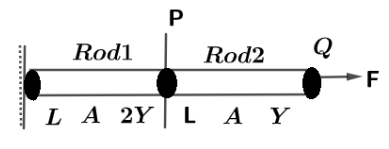
Consider an arrangement shown in the diagram which is a combination of two rods $(1)$ and $(2)$ .Their length, cross sectional area and Young modulus are shown in the diagram. If force $F$ is applied at the end of rod $(2)$ .then total elongation of the combined system is (P is the common end of rods $(1)$ and $(2)$ ).

A. $\dfrac{{3FL}}{{YA}}$
B. $\dfrac{{FL}}{{2YA}}$
C. $\dfrac{{3FL}}{{2YA}}$
D. $\dfrac{{FL}}{{YA}}$

Answer
506.7k+ views
Hint: In order to solve the above problem, we will find the elongation in each rods separately due to applied force and then add their elongation to get a net increase in length of the system.
Formula used:
Young modulus of a material is given as,
$Y = \dfrac{F}{A}\dfrac{{\Delta L}}{L}$
where $\Delta L$ denotes for elongation of a material and $A$ is the area of the cross section of given material.
Complete step by step answer:
Let us first find the $\Delta L$ for rod $(1)$ ,
We have, Force $ = F$
Young modulus $ = 2Y$
So, $\Delta {L_1} = \dfrac{{FL}}{{2AY}} \to (i)$ Using the Young modulus formula.
Similarly, we will find the elongation for rod $(2)$
Young modulus $ = Y$
So, $\Delta L$ for rod $(2)$ is given by,
$\Delta {L_2} = \dfrac{{FL}}{{AY}} \to (ii)$
Now, add both equations $(i)and(ii)$ we get,
$\text{Elongation} = \Delta {L_1} + \Delta {L_2}$
$\therefore \text{Elongation} = \dfrac{{3FL}}{{2AY}}$
So, the net elongation of the combined system is $\text{Elongation} = \dfrac{{3FL}}{{2AY}}$.
Hence, the correct option is C.
Note:Remember theoretically, Young modulus is defined as the ratio of stress (which is pressure acting on a material) to the strain (which is ratio of change in length of a body to its original length) and its SI unit is same as of Pressure $N{m^{ - 2}}$ . Also, in the given problem, Force was equally distributed along the line of two rods hence both rods were exerted by the same amount of force.
Formula used:
Young modulus of a material is given as,
$Y = \dfrac{F}{A}\dfrac{{\Delta L}}{L}$
where $\Delta L$ denotes for elongation of a material and $A$ is the area of the cross section of given material.
Complete step by step answer:
Let us first find the $\Delta L$ for rod $(1)$ ,
We have, Force $ = F$
Young modulus $ = 2Y$
So, $\Delta {L_1} = \dfrac{{FL}}{{2AY}} \to (i)$ Using the Young modulus formula.
Similarly, we will find the elongation for rod $(2)$
Young modulus $ = Y$
So, $\Delta L$ for rod $(2)$ is given by,
$\Delta {L_2} = \dfrac{{FL}}{{AY}} \to (ii)$
Now, add both equations $(i)and(ii)$ we get,
$\text{Elongation} = \Delta {L_1} + \Delta {L_2}$
$\therefore \text{Elongation} = \dfrac{{3FL}}{{2AY}}$
So, the net elongation of the combined system is $\text{Elongation} = \dfrac{{3FL}}{{2AY}}$.
Hence, the correct option is C.
Note:Remember theoretically, Young modulus is defined as the ratio of stress (which is pressure acting on a material) to the strain (which is ratio of change in length of a body to its original length) and its SI unit is same as of Pressure $N{m^{ - 2}}$ . Also, in the given problem, Force was equally distributed along the line of two rods hence both rods were exerted by the same amount of force.
Recently Updated Pages
Why are manures considered better than fertilizers class 11 biology CBSE

Find the coordinates of the midpoint of the line segment class 11 maths CBSE

Distinguish between static friction limiting friction class 11 physics CBSE

The Chairman of the constituent Assembly was A Jawaharlal class 11 social science CBSE

The first National Commission on Labour NCL submitted class 11 social science CBSE

Number of all subshell of n + l 7 is A 4 B 5 C 6 D class 11 chemistry CBSE

Trending doubts
What is meant by exothermic and endothermic reactions class 11 chemistry CBSE

10 examples of friction in our daily life

One Metric ton is equal to kg A 10000 B 1000 C 100 class 11 physics CBSE

1 Quintal is equal to a 110 kg b 10 kg c 100kg d 1000 class 11 physics CBSE

Difference Between Prokaryotic Cells and Eukaryotic Cells

What are Quantum numbers Explain the quantum number class 11 chemistry CBSE




